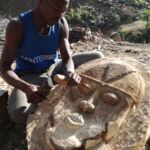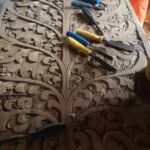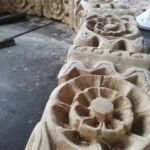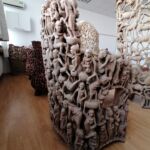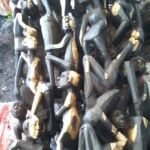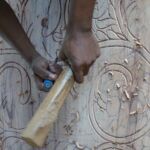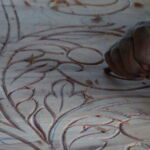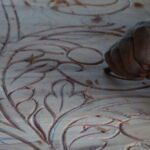The essence of Venda Art takes the form of furniture or decorative objects, made of wood and one-of-a-kind, is a luxury. Because, whatever the type of African artwork, from the idea to its realisation in its final form, it travels a path of perfection which is a meaningful journey.
One can love the choice made at Venda Art only when going through this creative process on a mental level, appreciating and feeling the energy and resources involved in creating African tribal art.
The Venda Art luxury furniture creation process
We set out to make as much of the creation process as possible visible, so that each piece of art created by the craftsmen in our team can be fully embraced.
On the road to perfection, a piece of African wood with a mission to become art always reaches ten milestones:
1. Conceptualisation
First, the inspiration and the idea of an art object or piece of luxury furniture appear in a sketch.
Specifically, these swirl around George, who defines the type of product, the design, the style of African art to be expressed, the size of the sculpture and some general lines of realisation. Then, a debate is launched in the European-African team to choose the most appropriate shape to be released from one or more pieces of solid wood.
2. Endorsements
Then, based on the sketch, which defines the size of the project (specifically of the piece of wood needed) we ask for the approval of the implementation of the idea from African Natural Resources, based on the annual authorization that the African craftsmen have and who will take over the project. In addition to this approval, the approval of all the tribal members of which all those involved in the project are members is also required and is at least as important as that of the authorities.
3. The first disengagement
The first phase of roughing out and defining a basic structure in the piece of solid wood begins. One or two craftsmen work for about two weeks in the place where the material is located, in the forest, away from the road and the carving workshop. This is done for the simple reason that the piece of wood, in its raw form, initially weighs several hundred kilograms. Later, even though the structure obtained to start the actual carving is still extremely heavy, it is laboriously brought to a road and from there, it is transported by car to the workshop.
4. Refining the concept
In this phase, the final idea is decided on the basic structure and the first stylistic and elemental milestones are drawn up following team discussions. The visions of the artists involved are pooled, based on George’s idea, and the defining elements of the work are agreed. In this way, it will be possible to combine African artistic style with European, often British, design.
5. Rough sculpture
Now a creative stage begins in the studio and this involves transforming the wood into a rough, unfinished form of the object to be carved. This stage can take between 6-12 months, varying according to the size, style, material used and complexity of the work. It also depends on unpredictable weather conditions, which can sometimes make the process more difficult.
6. Fundi Knife
Once we establish that the African craftsman has completed this part of his work, the “fundi knife” stage follows, which involves scraping the material behind the carver. This is done by a skilled craftsman and can take up to a week.
7. Fundi Polish
Approximately two weeks later the wood goes through the period called “fundi polish”. This involves polishing the piece by another craftsman with strict experience in this task.
8. Acclimatisation
The finished product is brought to Europe, where it is left to acclimatise for several weeks. This part is essential because we follow all the transformations of the wood, its moisture content and all the other characteristics that will lay the foundations for the piece of art’s resistance over time. We make sure the wood is thoroughly dry, not just on the outside. And this is important because, even though wood works all its life, we do our best not to encourage cracks that can destroy design details.
9. Varnishing
Next comes varnishing, which coats and protects the creation and takes a specific amount of time to dry properly.
10. Final details
The last stage is devoted to finishing the details, whether it is upholstery or the purchase of other elements that complete the final piece. Adding again a variable amount of time, sometimes a week, to make sure that the sketch has become the one-of-a-kind piece of art as planned.
That’s why the value of all our products is reflected in the lengthy creation time, in addition to their uniqueness and perfect quality. It’s just a well-known fact that things of value always take time and they stand the test of time, turning into long-term investments.


